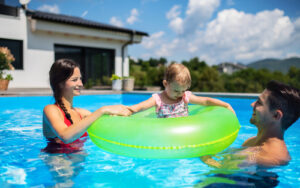 Pools are one of the best parts of the summer. But, for children, they can also be one of the deadliest.
Pools are one of the best parts of the summer. But, for children, they can also be one of the deadliest.Every year, 350 children die of drowning, and most of those cases occur in a backyard pool, according to the Consumer Product Safety Commission. It is the leading cause of death by unintentional injury in children ages 1 to 4 and the second leading cause for those ages 5 to 9, according to the Centers for Disease Control.
The good news is that drowning is entirely preventable. With these recommended steps, you can keep your children safe.
Be your own lifeguard. Beaches and public swimming pools have a lifeguard for a reason. That reason doesn’t go away when it comes to backyard swimming pools. Always keep an eye on your children. Don’t get lost in a book. Don’t scroll through Instagram or take breaks inside. For children, drowning can occur in just 30 seconds. If you’re having a party, pool safety advocates recommend designating one parent as a ‘water watcher.’ You can have the duties rotate so everyone can enjoy the party, but at least one adult always has to have their eyes on the pool.
Know the signs. Being an effective ‘water watcher,’ presumes that you know the signs. When it comes to kids drowning, it might not look like what you expect—splashing and flailing around. Instead, look for kids who are vertical in the water, quiet, and have their heads tipped back. When in doubt, act—it’s best to intervene before a kid is in trouble.
Learn CPR. Just as important as knowing the signs is knowing how to do CPR. Parents.com has a very basic online guide here. But you should take a class. They are available from hospitals, community organizations, and the American Red Cross.
Teach your children how to swim. Making sure your kids have swim lessons not only ensures they have more fun, it also is one of the best antidotes to drowning. Besides swim lessons, drill your kids in basic pool safety etiquette: Don’t run around the pool. Don’t push other kids into the pool. And don’t dive in head-first unless you’re in an area of the pool deep enough for that.
Make sure your children are equipped. Weaker swimmers should wear life jackets—water wings and floating toys are not sufficient alternatives. Loose hair should be tied up to avoid getting caught in drains.
Good fences. Having a fence around your pool is a safety must. Fences should be at least four feet high. Having a gate that is self-closing and self-latching ensures the fence will be effective. Installing a pool door alarm is an added safety measure. If the pool is going to go unused for a long period of time, then cover it.
Deadly drains. Drains are one of the hidden hazards of pools (and also hot tubs and spas.) Hair, limbs, and jewelry can all get caught in a drain, leading to either drowning or serious injury. Never let your children get into a pool with a drain that isn’t covered or has a broken cover. At home you can mitigate the risk further by installing anti-entrapment drain covers and safety release systems.
The hazards pools pose are indeed scary. But, by taking the above steps, you can put your mind at ease, knowing that you have done everything necessary to ensure your kids are safe. Enjoying the pool without that anxiety will make it that much more fun.





